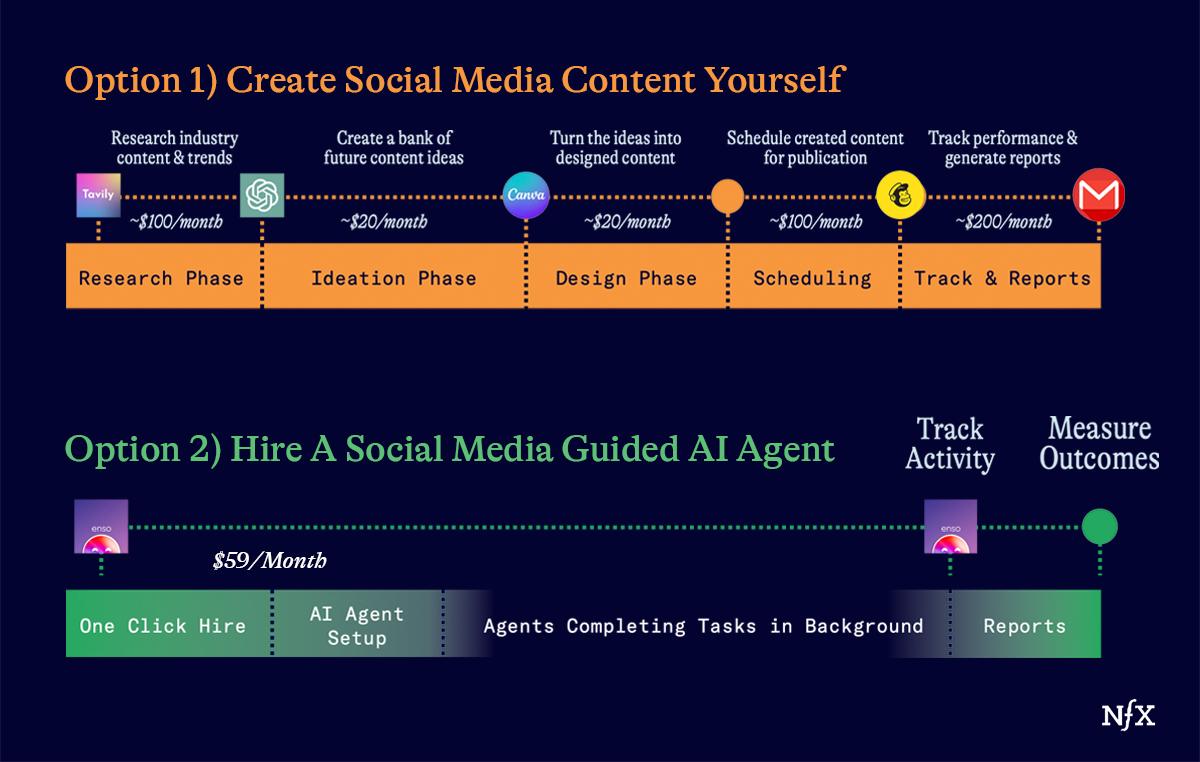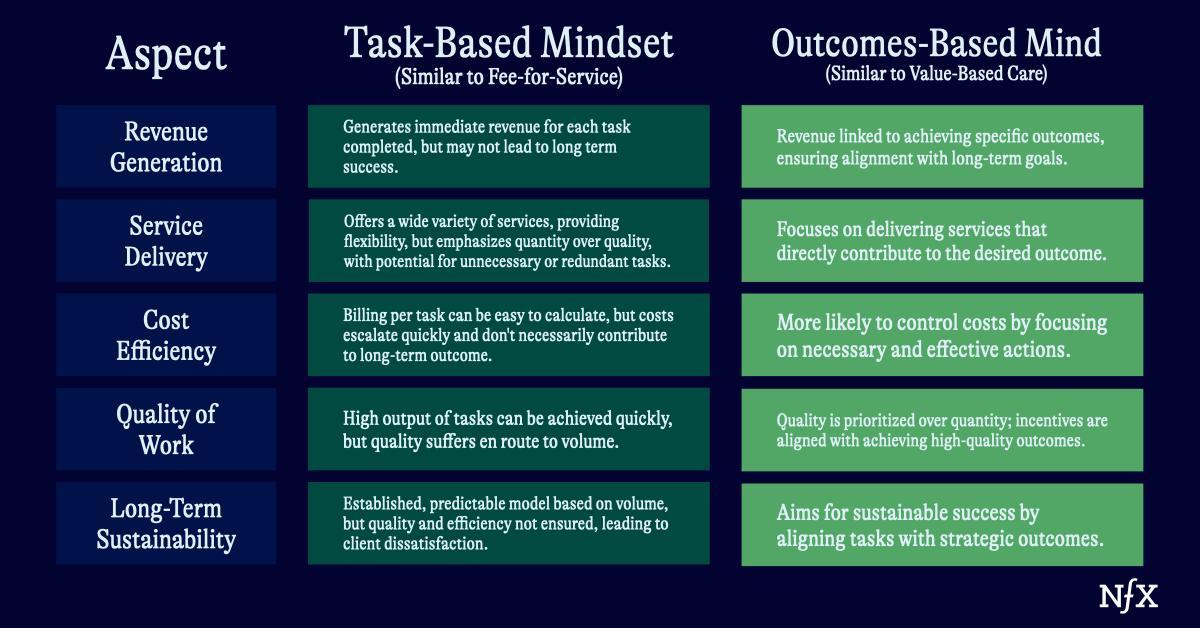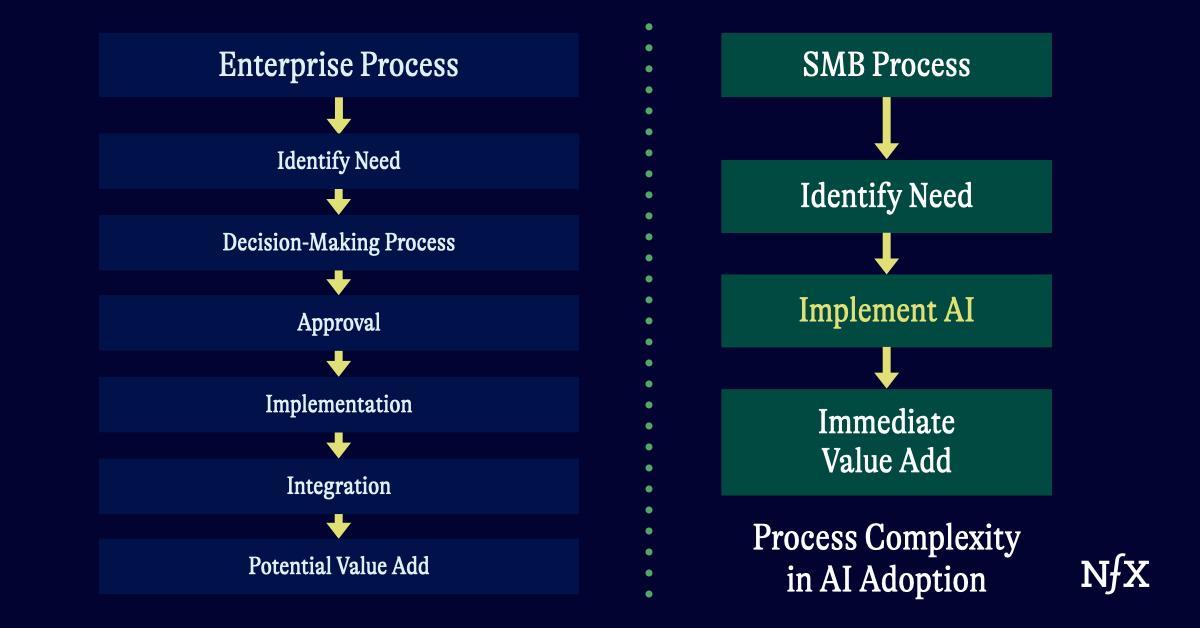

The “service-as-a-software” universe is large and exciting. Within it, you will have AI assistants, co-pilots, fully automated AI workers, and so on. All of these names are grappling with the same major step-change in the labor economy, which NFX has been investing in for a while now.
But within this universe, certain clusters of outsized opportunity are forming.
One of these clusters is the use of Guided AI Agents for SMBs.
I recently told TechCrunch that until now, small businesses have been largely bypassed by the AI revolution. I want to go deeper here and explain how this is about to change.
A new generation of Guided AI Agents is about to turbocharge SMBs – the companies that employ nearly half of all American workers – and allow them to finally compete with large enterprises.
From “AI Tools” to “Guided AI Agents”
The AI-turbocharged SMB begins with a series of mindset shifts. The first is from “AI tools” to “Guided AI Agents.” We already have this technology in hand. The shift is about more people understanding what this technology means.
This very moment, we could easily automate away 60% to 70% of the global economy’s work hours with AI. But we’re nowhere near achieving this. That’s because we view our current LLMs or other AI systems as tools in an existing workflow. ChatGPT for writing copy, or DALL-E for making images, etc.
How much time are our current AI workflows really saving us? Not as much as you think. That’s because humans are still the ones copying + pasting, or fine tuning the assets, or porting things from SaaS product to SaaS product. AI is doing a lot of specific knowledge or skill work, but humans are still executing most of the actions and workflows.
Think about what it takes to get an article placed in a trade magazine. You have to write a press release, compile a list of journalists who might be interested, write emails pitching them on the story. In theory, you could pay for an AI tool specialized for each one of those tasks. And you, the human, still have to move your materials between those tools.
That’s a lot of chaperone work. Babysitting.
We need to think bigger.
AI is capable of both knowledge AND action. The coupling of knowledge + action is a critical moment for this field, because AI stops being a tool and starts being a collaborator.
This is where the idea of Guided AI Agents comes in.
Let’s be clear about what is different about an AI agent and a Guided AI Agent. Presently, an AI agent will use an LLM to generate a to-do list of tasks, and integrations with existing software to execute those tasks. But, that to-do list, if created by a more generalized LLM, may not be ideal for your industry or need.
A generalized AI Agent might understand the broad strokes of your field. But it may not realize exactly what kind of social media tone or posting cadence is socially normal for your type of business in your type of industry for your type of customers
A Guided AI Agent sets a series of guideposts and predefined steps for that LLM to follow as it generates the task list. For example, an LLM asked to create content for a healthcare startup will know that it should only generate content based on verified medical sources.
Guided AI Agents string workflows together. You could, in theory, ‘hire’ a GGuided AI Agent to “place your story in a trade magazine” and the AI will execute that list of tasks autonomously, moving seamlessly from one task to the next to get the job done, unique to your industry and your outcomes. Just like buying a service from an agency or a freelancer.

 We saw hobbyists moving in this direction months ago. Individuals have already tasked ChatGPT with building entire online businesses, or used it to develop viral social media accounts. Now SMBs are adopting this mindset.
We saw hobbyists moving in this direction months ago. Individuals have already tasked ChatGPT with building entire online businesses, or used it to develop viral social media accounts. Now SMBs are adopting this mindset.
NFX-backed Enso was one of the first companies to recognize this. Enso is a platform developing industry-specific Guided AI Agents capable of executing full workflows at low cost, like creating marketing campaigns, doing sales outreach, or executing HR tasks. These AI agents are “hireable” as virtual freelancers, who focus on completing these complex goals.
From “Tasks” to “Outcomes”
Because of Guided AI Agents, we can now think of work in outcomes rather than tasks.
As we just mentioned, with Guided AI Agents, we can scrap the to-do list and all the chaperoning in between. The guided agent will execute all of that autonomously.
Which means: You can measure success in new customers gained, articles placed, deals closed. Outcomes. All of your processes and KPIs are replaced with a simple yes or no question: did the guided agent succeed or not?
This mindset shift can unlock huge value for companies and customers. We’ve seen it happen before in the healthcare space as we transition from fee-for-service based care to value-based care.
Value-based healthcare focuses on creating the best possible experience and outcome for the patient. This view reduces long term costs, curbs wasteful spending, incentivizes long-term thinking, improves patient satisfaction, and rewards quality and efficiency. While fee-for-service can generate immediate revenue and offers a wide array of services to choose from, it also leads to unnecessary procedures, higher healthcare costs, fragmented care, and focus on quantity of care over quality.
Most of the B2B software space right now, even in AI, is more like the fee-for-service model. When you charge for a service (a tool), you end up emphasizing quantity over quality. It’s a volume game. Cost can balloon. And you need to pay no matter what the ultimate outcome is. In our above example, you have to pay for a press release, even if you don’t get placed in a magazine.
Agencies typically prefer a fee-for-service based model. This makes sense, as they will put lots of effort into the process itself. The best will achieve that goal. The rest may, or may not – but that price stays the same.


With Guided Agents, we can focus on outcomes. When you charge based on value, you emphasize quality over quantity. You prioritize efficiency, and spend less time and money on inconsequential steps en route to your final goal. Your results translate directly to your value, so you get better results. Again in our above example, you earn most of your keep when you actually land the story in the magazine.
With AI agents, the price-per-performance is a far easier sell. To a Guided AI Agent, effort is not measurable. Performance, however, is.
Ultimately, we think that this shift from tasks to outcomes is going to spread throughout every industry, into businesses at every size. However, there’s a unique opportunity to serve primarily SMBs with this technology. By bringing guided agents to the SMB, there’s a potential to empower a large section of the US economy that is often overlooked by cutting-edge technologies. The SMB is where we will see the concept of Guided AI Agents truly take off.
Guided AI Agents Will Roll Out Faster In SMBs
The rise of Guided AI Agents is going to turbocharge SMBs. We expect this concept to take off faster among these business types compared to large enterprises.
For a small business that couldn’t otherwise hire a person or a fancy agency, the idea of an AI agent is all upside. It’s not a matter of replacing human workers, or reorganizing a department…it’s simply a value-add that allows SMBs to do things they could never do otherwise.
You could hire an accountant. Run a social media account. Open and operate a website and online store with a small team. It increases options rather than limits them. That’s the kind of value proposition that allows you to grow quickly.
As a result, we see that AI has been adopted quickly among SMBs: today 93 percent of SMBs surveyed by the Small Business Council agreed that AI is saving them money and improving profitability. 31% say they’re going to be “significantly” investing in AI in the next year.
Compare this to the process of rolling out an AI agent within a large enterprise. Incumbents have accrued a lot of value in the Generative AI Era, but many aren’t rewiring themselves from the inside out to have an AI-first mentality. Even if they are – it’s not happening as fast as it could be, because the process takes longer than you might think.
In large enterprises, decision-makers are harder to find. Processes are entrenched across departments. There are likely far more proprietary processes and datasets in place. Hiring an AI freelancer and giving them the keys to a secure CRM or social account is more likely to ruffle feathers.


As a result, we’ve seen the rise of AI agents leak slowly across the large enterprise space. Generative AI use in the enterprise could be worth $2.6 – $4.4 trillion annually, but that value is only unlocked if enterprises can quickly reimagine and transform how they do their work across the “chain of productivity.”
Put simply: larger enterprises are going to be slower to make that mindset shift from tasks to outcomes because their lists of tasks are infinitely long and complex. And also because using an AI agent would usually require the agent ‘working on’ multiple complex systems, often proprietary, and accessing multiple internal data sources to complete a task. These complexities do not exist with small businesses.
That’s why for the SMB, it’s value-added from day 1. You’re filling a gap, not ripping out a system.
By focusing on SMBs first, this next generation of AI agents can move quickly to gain market share. On a societal level, we think this has the potential to truly 10x the capabilities of the SMB and power-up a massive section of the US economy.
Why Guided AI Agents Will Turbocharge the SMB
To really make a step-change in the economy, you need speed and scale. We know that Guided AI Agents are going to roll out rapidly across the SMB landscape. But most people aren’t seeing why this is such a huge change.
For one, the SMB tapestry is massive. SMBs are a huge share of the American economy, representing 44% of GDP, close to half of all employment and $370 billion in overall tech spending. Globally, SMBs spend even more – about $750B on all IT services.
And second, these AI tools are the first time that SMBs are going to have access to tools needed to scale like large enterprises. That means that the market power of SMBs is going to go exponential.
That’s due to two driving forces.
1. We can finally deliver uniqueness at scale
If you dive deeper into the SMB market, you find a highly diverse ecosystem. There are 5.8M SMBs, compared to 17,500 enterprises. An enterprise software company can sell to a few firms with 500+ employees. An SMB software company is charged with selling to many firms of 10 employees or fewer, each likely to have specific asks.
This tapestry of SMBs requires uniqueness at scale. That was nearly impossible to build in the pre-AI era. But now, it’s not a problem for Guided AI Agents, which are more than capable of uniqueness at scale.
Enso has already used Guided AI Agents to solve the unique needs of many SMBs. These guided agents operate using industry specific software, best-practices, and templates. They’re not generalized tools – they’re specific enough to serve each SMB, but intelligent enough to create unique outcomes at scale. And over time, Enso plans to allow developers to create these guided agents themselves, and sell their services within a marketplace. Similar to what we’ve seen with Custom GPTs, this allows people to create full AI agents that meet SMBs needs right out of the box.
2. Runs in the background
Many of the biggest SaaS companies – Hubspot, Wix, Salesforce, etc. – began by serving SMBs, before expanding to large enterprises. But for many SMBs, the time investment it took to learn these processes was a luxury they couldn’t afford (in addition to subscription fees).
While growing up, Enso’s CEO Mickey Haslavsky noticed that his mother and father – a secondary school manger and music production studio owner – struggled to embrace digital tools. At first, he thought it was a generational gap. He tried to bridge it himself by sending them SaaS tools or connecting them with outside agencies.
Neither approach worked. The agencies were too expensive. The SaaS products were way too much of a heavy lift for his parents, both from time and skillset perspectives. They required constant monitoring.
Now, GuidedAI Agents run in the background, requiring no additional time investment from the SMB. You don’t even need to understand how it’s working – as long as the job gets done.
It’s like working with an agency, without the agency. And at the price point an SMB could actually afford.
The Backbone for the Next-Generation of SMBs
With companies like Enso, there will be Guided AI agents for any task – and any outcome – an SMB owner could imagine. These services will create a new infrastructural backbone for SMBs. It will soon be the easiest it has ever been to start and to grow a small business with AI agents at your disposal.
It used to be that you had to be a large enterprise to have access to all these different services needed to grow.
Not anymore. The SMBs are finally getting the chance they have always deserved.
As Founders ourselves, we respect your time. That’s why we built BriefLink, a new software tool that minimizes the upfront time of getting the VC meeting. Simply tell us about your company in 9 easy questions, and you’ll hear from us if it’s a fit.


